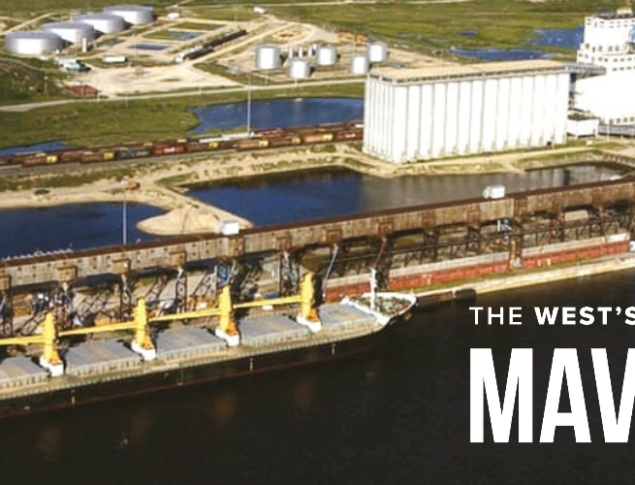Back in April of 2022, Peter Mackay wrote an article on the port of Churchill titled: “Manitoba could become Europe’s not-so-secret weapon against Russia”.
I have been saying for many years in local circles that Western Canada should be making better use of the Port of Churchill, and it is an idea whose time has come. I am old enough, and have farmed long enough to have had grain shipped through the Port of Churchill back in the days of the Canadian Wheat Board. That is another topic.
The Port of Churchill started with the completion of the Hudson Bay Railroad, that in its day, was an amazing feat of rail road engineering crossing the Canadian shield, with all its lakes, muskeg, and waterways. The actual Port was built and it received its first grain in 1931. As the rail network in Western Canada grew and rail bed capacity was upgraded, Churchill was limited by railcar loading weights due to poor railbed conditions, it was often looked at as a “Last Resort” to ship grain through the port as heavier cars could be loaded and put on the main line to Thunder Bay, Prince Rupert, or Vancouver keeping freight rates per ton (later, Tonne) of grain lower.
Further added to the demise of the port was the fact that as farmers, shipping grain through Churchill, we had to pay a penalty to the Port of Thunder Bay for “Lost Handle” of grain that they felt should be shipped through the Great Lakes and St. Lawrence Sea Way so those authorities and shipping companies could make money instead of the farmer from the Prairies. Yes, the East always finds a way to pull money out of Western Canada.
Fast forward to the late 1990’s and with the railbed in disarray, Canadian National Railway has no interest in upkeep of the railway, so enters OmniTRAX who purchases the Port of Churchill. Money is poured into railbed upgrades but very little of anything from Western Canada gets shipped through the Port. Finally in September of 2018, the Hudson Bay Rail Line, The Port of Churchill, and the Churchill Marine Tank Farm, are acquired by Arctic Gateway, and the first train arrives in Churchill in November.
The Port of Churchill is a deep-water port that has four berths for loading and unloading grain, manufactured, mining and forestry commodities, general cargo and tanker vessels, according to Arctic Gateway. This last part is interesting because there is a tank farm at the port that is for, and I quote, “Shiploads of fuel can be unloaded at the port and storing it in the tank farm on their way to heating and powering the North.” They can also receive fuel by rail and store it in nine (9) 85,000 litre double wall storage tanks to be distributed to the town of Churchill, the airport and surrounding area. Quite interesting.
Satellite images show the small 9 tank farm nestled to North-North-East of the grain terminal right across Axworthy Way. Alongside that are 5 smaller refinery style tanks that look to be 45 to 50 feet in diameter along with 4 large tanks on the other side of the rail line spur that are around 120 feet in diameter. Even if these larger tanks are not being used, they are there, so at one time there was some sort of capacity to handle large quantities of product at the port.
In my mind, I am wondering, why can’t Western Canada ship petroleum products to overseas markets through the Port of Churchill? Russia has been shipping goods through Northern ports for many years. Pipeline technology in Canada is second to none, crossing every type of obstacle imaginable in its path with an exemplary safety record.
What is standing in the way?
There is no road into Churchill, just a rail line, by sea, and air travel. Any equipment of any size has two ways in, rail or vessel. Would it not be an option to have a road also? If there was a road built, could it be part of a Western corridor so to speak, from Northern Manitoba to BC capable of pipeline, power line, road and rail capable of moving goods and energy from the West to the world with distribution points along the way to gather and distribute goods along the corridor to communities and enterprises North and South?
Political will is all that is standing in the way, both federally and provincially.
Western Canada has the expertise, and the ability to safely transport and ship just about any petroleum product through the Port of Churchill to an energy hungry world. Northern Manitoba has a vast capacity to produce Electricity and forestry products as does British Columbia. Manitoba has many mined resources that need an outlet to world markets. Alberta, and Saskatchewan have coal, and potash looking for markets in other provinces and the world. What benefit would this have to Northern areas and communities across the West?
The port of Churchill can become an economic trade hub for Western Canada goods, grain, forestry products, mining, and energy. I would urge anyone to take a serious look into the Port of Churchill, not only for what is established there already, but to look toward the future and envision the potential this port has.
Bevan D. Kelbert
Executive Council, Manitoba Representative
Maverick Party
Note: copy and past link to OmniTRAX article

